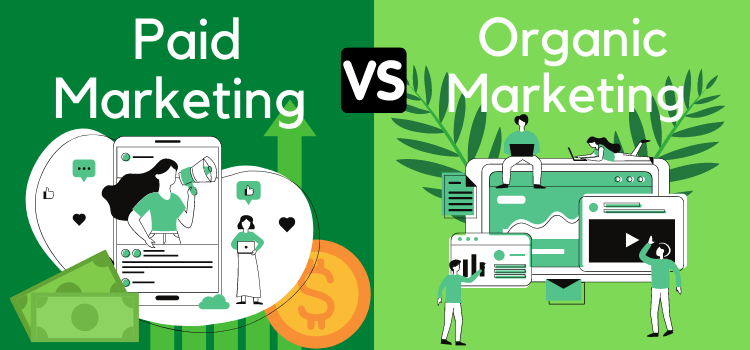Organic marketing vs paid marketing
It can be not easy to decide where, when, and how to use the many digital marketing tools available at your fingertips. Using the right method to target your audience, reach, engage, and convert is critical for the growth of your business. And because all digital marketing tactics ultimately fall into one of two categories—organic or paid—it’s beneficial to understand how to use both to further your business goal.
If you want to know the best way to reach, engage, and convert your target audience, then Metaloop marketing is here to save your digital way. We are the best digital marketing agency in India. At Metaloop, we use both organic and paid marketing.
Our strategy for acquiring customers includes a significant amount of content marketing, and we focus on producing content that will perform well in search engine results. These pieces of content—both video and text—are distributed via other organic channels: email and social media.
We also use paid marketing to spread the word about our content. To further increase the reach of the majority of our content, we run ads on websites like Facebook, Twitter, and Quora.
To better understand how paid and organic marketing complement one another to form a comprehensive and symbiotic marketing strategy, let’s explore them in more detail and highlight their key differences.
What is organic marketing?
Organic marketing, or inbound marketing, is a type of marketing that drives traffic to your website or brand without paying for advertising. It commonly involves creating and distributing valuable content to attract an audience, also known as “content marketing.” It occurs naturally as you build the brand and create a relationship with the customer by providing them with valuable and engaging content.
Organic marketing often focuses on search engine optimization (SEO), social media, and various other channels to bring readers to your website through the search engine results after they search for relevant keywords and topics that relate to your content. Instead of interrupting customers with annoying ads, organic marketing’s main goal is to build connections with the audience through educational and entertaining content.
To measure the effectiveness of your organic marketing efforts, you’ll look at which channels are driving the most traffic to your site, the leads from those campaigns, and which channels get the highest amount of high-converting traffic to your site.
Content marketing is an essential element of organic marketing. The content you create is informative, useful, and relevant to attract, engage, and nurture your audience.
Some examples of organic marketing:
- SEO
- Email newsletters
- Guest posts
- Link generation
- Blogging (Companies that blog receive 55% more traffic than companies that don’t)
- Unpaid social media posts
What is paid marketing?
Paid marketing, also known as “inorganic marketing,” is a type of marketing where companies pay a publisher to publish ads for their company. It includes paid search ads, social media ads, sponsored posts, display ads, YouTube videos, etc. Paid marketing helps you target your ideal audience and reach people who might have never heard about your business. It frequently entails buying clicks from websites like Google, Facebook, and Twitter, as well as banner ads and sponsored posts.
Paid marketing enables companies to quickly and effectively target, reach, engage, and convert their audiences. In short, it generates more traffic and reaches a broader audience in a short period of time. Pay marketing aims to convert potential customers into sales with specific campaigns. The marketers track conversion and engagement rates for each advertisement to measure the success of paid marketing campaigns. You can measure the success of paid marketing by using the return on ad spend (ROAS). It is a revenue-measuring metric that compares every dollar of sales from the ad to the money spent on the ad campaign.
Some examples of paid marketing:
- Pay-per-click
- Google ads
- Facebook ads
- Display advertisement
Pros and cons of Organic marketing
Here are some of the main advantages of organic marketing:
cost less than the paid
Organic marketing costs for posting and updating blogs using social media and sending emails are low.
Help to build a relation.
Organic marketing involves creating organic content that helps you build relationships with customers who will be much more likely to invest in your product with less convincing.
Increase brand authority
Your brand authority rises when you perform organic marketing properly. Organic marketing has the power to alter consumers’ perceptions of products and services. Businesses that use SEO best practices see an increase in organic traffic and visibility. That ultimately benefits. Prospects who are familiar with the brand are more likely to make purchases. About 59% of consumers prefer to purchase from trusted brands.
Drive traffic
The more relevant the content is for the reader, the more likely they will keep consuming it and create a lasting relationship with your brand. It helps to grab the attention of people who would not otherwise have seen your website and need a little convincing before they purchase.
Here are some of the main disadvantages of organic marketing:
Time-consuming
Organic marketing takes months or even years to grow a brand and generate results. You have to spend a lot of time creating content for little. If you are providing relevant and engaging content, it will be worth the effort in the long run.
SEO tactics are constantly changing:
What works today may not work tomorrow, so you must constantly change and update your organic marketing strategy. Keeping on top of SEO can feel like an endless endeavor, but the return is worth the hassle, and SEO can be used to improve other aspects of your marketing strategies.
Pros and cons of Paid marketing
Here are some of the main advantages of paid marketing:
Build brand awareness
Paid marketing helps expand the reach and increase brand awareness quickly. Without having to wait for your organic content to gain traction, you can quickly get your brand in front of your ideal audience by appearing at the top of search engine result pages using paid ads.
PPC plays nice
PPC is neither exclusive nor unaffordable. Ads are simple to integrate into other marketing initiatives, such as organic social media marketing, email marketing, and organic search marketing. This means that you can combine your organic marketing efforts with PPC ads.
Get quick sales
Paid marketing makes it easy for you to track sales. You can see how many people clicked on which ads and how many of them ended up becoming customers with the help of Google Analytics. This has a higher potential for sales because you directly satisfy a customer’s need.
Here are some of the main disadvantages of paid marketing:
Cost
Paid advertising works only as long as you keep paying for your ads to show up on Google searches and social media channels. The moment you stop paying, they stop appearing. The price can increase when your competitors pay the same amount for the online space you need.
Paid advertising can quickly become very involved.
Managing your paid advertising can take a lot of time, depending on your customization choices. It requires commitment and knowledge of how quickly things change in online marketing. It needs constant analysis and updates; you can’t just set it up and leave it. Paid advertisements must be checked and updated frequently to stay relevant; otherwise, they won’t be relevant enough to appear.
Difference between organic marketing VS paid marketing
In the end, both organic and paid marketing have the same objective: promoting a business’s goods and services to increase brand traffic. However, there are a few considerable differences:
Organic marketing can be evergreen, while paid marketing is temporary:
Organic marketing is evergreen. Brands create content that endures and ranks in search engine for months or even years after it is published. If the blog posts hit the internet, they will continue to bring in more traffic. On the other hand, Paid advertising is only effective while you are still paying for it.. As soon as payment is stopped, ads are no longer displayed.
Organic marketing is less expensive than paid marketing:
Organic marketing is also cheaper than paid marketing. As long as you know SEO, you can optimize your website and other content for organic search with less cost. On the other hand, paid marketing is typically costlier than organic marketing, but paid marketing still provides a healthy ROI.
Organic marketing result takes time, while paid marketing result is instant.
Organic marketing takes significant time and effort to get right; it might take a week or even a month to see the result. And if you don’t have the time to wait, paid marketing can get your products and services in front of viewers sooner. Let’s say you want to use paid marketing to get results more quickly. In that case, you’ll need to consistently optimise your ads, follow best practises for AdWords, develop a successful landing page, and operate within a reasonable marketing budget.
Organic marketing vs paid marketing: which is better
Organic marketing and paid marketing both have some strengths and weaknesses. Which is better for your company is determined by your overall strategy, goals, campaign, audience, and the amount of time available to develop your content marketing strategy to achieve the goal. If your company is a start-up that needs to build quick brand awareness, paid marketing is the best option. But suppose you want to deliver the right message at the right time, nurture those potential customers to make sales, and increase customer lifetime value. In that case, you should invest in organic marketing.
The goal is to use the type of marketing that makes the most sense for your desired outcomes.
Organic and paid marketing often perform best when you use a smart mix of the two. But in order to achieve the best return on investment, you must have a plan for balancing the two approaches.
Metaloop’s digital marketing services help you understand your target audience and how best to reach them. It includes a strategy that works for you over time while maximizing your use of the created content.



Write a Comment